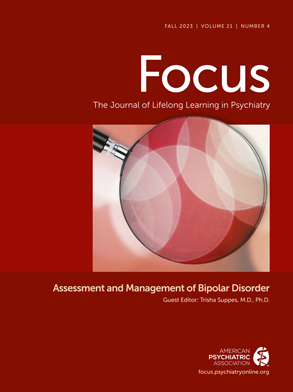Given space limitations and varying reprint permission policies, not all of the influential publications the editors considered reprinting in this issue could be included. This section contains abstracts from additional articles the editors deemed well worth reviewing.
Long-term Morbidity in Bipolar-I, Bipolar-II, and Unipolar Major Depressive Disorders
Forte A, Baldessarini RJ, Tondo L, et al.
J Affect Disord 2015; 178:71–78
BACKGROUND: Long-term symptomatic status in persons with major depressive and bipolar disorders treated clinically is not well established, although mood disorders are leading causes of disability worldwide.
AIMS: To pool data on long-term morbidity, by type and as a proportion of time-at-risk, based on published studies and previously unreported data.
METHODS: We carried out systematic, computerized literature searches for information on percentage of time in specific morbid states in persons treated clinically and diagnosed with recurrent major depressive or bipolar I or II disorders, and incorporated new data from one of our centers.
RESULTS: We analyzed data from 25 samples involving 2,479 unipolar depressive and 3,936 bipolar disorder subjects (total N=6,415) treated clinically for 9.4 years. Proportions of time ill were surprisingly and similarly high across diagnoses: unipolar depressive (46.0%), bipolar I (43.7%), and bipolar II (43.2%) disorders, and morbidity was predominantly depressive: unipolar (100%), bipolar-II (81.2%), bipolar-I (69.6%). Percent-time-ill did not differ between UP and BD subjects, but declined significantly with longer exposure times.
CONCLUSIONS: The findings indicate that depressive components of all major affective disorders accounted for 86% of the 43–46% of time in affective morbidity that occurred despite availability of effective treatments. These results encourage redoubled efforts to improve treatments for depression and adherence to their long-term use.
Copyright 2015 Elsevier. Reprinted with permission.
Lithium Versus Other Mood-Stabilizing Medications in a Longitudinal Study of Youth Diagnosed With Bipolar Disorder
Hafeman DM, Rooks B, Merranko J, et al.
J Am Acad Child Adolesc Psychiatry 2020; 59:1146–1155
OBJECTIVE: Lithium is the mainstay for bipolar disorder (BD) treatment in adults, but evidence in youths is limited. We used data from the Course and Outcome of Bipolar Youth (COBY) study to assess whether lithium vs other mood-stabilizing medication (OMS) was associated with improved outcomes, including mood symptoms and suicidality.
METHOD: COBY is a naturalistic, longitudinal study of 413 youths, 7 to 17.11 years old at intake, with BD. At each visit, medication exposure, psychiatric symptoms, and psychosocial function over the preceding follow-up period were assessed using the Adolescent Longitudinal Interval Follow-Up Evaluation. Using mixed models, we determined whether participants taking lithium vs OMS (but not lithium) differed regarding mood symptoms, suicidality, psychosocial function, hospitalization, aggression, and substance use.
RESULTS: A total of 340 participants contributed 2,638 six-month follow-up periods (886 lithium, 1,752 OMS), over a mean follow-up of 10 years. During lithium (vs OMS) follow-up periods, participants were older, less likely to have lifetime anxiety, and less likely to be on antidepressants (p values<.005). After covariate adjustment, the lithium group (vs OMS) had half as many suicide attempts (p=.03), fewer depressive symptoms (p=.004), less psychosocial impairment (p=.003), and less aggression (p=.0004). Similar findings were observed in the subgroup of follow-up periods in which participants were <18 years old.
CONCLUSION: Findings are consistent with adult studies, showing that lithium is associated with decreased suicidality, less depression, and better psychosocial functioning. Given the paucity of evidence regarding lithium in children and adolescents, these findings have important clinical implications for the pharmacological management of youths with BD.
Copyright 2020 Elsevier. Reprinted with permission.

